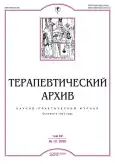Диагностика и лечение наследственного ангиоотека с нормальным уровнем С1-ингибитора
- Авторы: Емельянов А.В.1, Лешенкова Е.В.1, Каменева Г.А.2
-
Учреждения:
- ФГБОУ ВО «Северо-Западный государственный медицинский университет им. И.И. Мечникова» Минздрава России
- ГБУЗ АО «Архангельская областная клиническая больница»
- Выпуск: Том 92, № 12 (2020)
- Страницы: 86-90
- Раздел: Статьи
- URL: https://journals.rcsi.science/0040-3660/article/view/60261
- DOI: https://doi.org/10.26442/00403660.2020.12.200447
- ID: 60261
Цитировать
Полный текст
Аннотация
Наследственный ангиоотек (НАО) с нормальным уровнем С1-ингибитора является редким потенциально жизнеугрожающим заболеванием с аутосомно-доминантным типом наследования, которое впервые описано в 2000 г. Клинические проявления его напоминают НАО с дефицитом С1-ингибитора. В обзоре приводятся данные о распространенности, механизмах развития, генетике и диагностических критериях НАО с нормальным уровнем С1-ингибитора. Обсуждаются различные подтипы этого заболевания и принципы лечения (купирование симптомов, краткосрочная и длительная профилактика). Описан клинический случай семейного НАО с нормальным уровнем С1-ингибитора и мутацией гена плазминогена у 2 пациенток. Особенностью заболевания явились поздняя постановка правильного диагноза (через 10–25 лет после начала болезни), отягощенная наследственность (наличие аналогичной мутации гена плазминогена у 3 кровных родственников женского пола, у одной из которых – без клинических симптомов), сочетание в клинической картине у двух родных сестер ангиоотеков лица, языка, гортани и абдоминальных атак.
Полный текст
Открыть статью на сайте журналаОб авторах
Александр Викторович Емельянов
ФГБОУ ВО «Северо-Западный государственный медицинский университет им. И.И. Мечникова» Минздрава России
Автор, ответственный за переписку.
Email: emelav@inbox.ru
ORCID iD: 0000-0002-8574-6869
д.м.н., проф.
Россия, Санкт-ПетербургЕвгения Владиславовна Лешенкова
ФГБОУ ВО «Северо-Западный государственный медицинский университет им. И.И. Мечникова» Минздрава России
Email: emelav@inbox.ru
ORCID iD: 0000-0003-4616-3166
к.м.н., доц.,
Россия, Санкт-ПетербургГалина Альбертовна Каменева
ГБУЗ АО «Архангельская областная клиническая больница»
Email: emelav@inbox.ru
ORCID iD: 0000-0002-2328-9420
врач аллерголог-иммунолог
Россия, АрхангельскСписок литературы
- Binkley KE, Davis A 3rd. Clinical, biochemical, and genetic characterization of a novel estrogen-dependent inherited form of angioedema. J Allergy Clin Immunol. 2000;106(3):546-50. doi: 10.1067/mai.2000.108106
- Bork K, Barnstedt SE, Koch P, Traupe H. Hereditary angioedema with normal C1-inhibitor activity in women. Lancet. 2000;356(9225):213-17. doi: 10.1016/S0140-6736(00)02483-1
- Bork K, Gül D, Dewald G. Hereditary angio-oedema with normal C1 inhibitor in a family with affected women and men. Br J Dermatol. 2006;154(3):542-5. doi: 10.1111/j.1365-2133.2005.07048.x
- Maurer M, Magerl M, Ansotegui I, et al. The international WAO/EAACI guideline for the management of hereditary angioedema-The 2017 revision and update. Allergy. 2018;73(8):1575-96. doi: 10.1111/all.13384
- Zuraw BL, Bork K, Binkley KE, et al. Hereditary angioedema with normal C1 inhibitor function: consensus of an international expert panel. Allergy Asthma Proc. 2012;33(Suppl. 1):S145-56. doi: 10.2500/aap.2012.33.3627
- Busse PJ, Christiansen SC. Hereditary Angioedema. N Engl J Med. 2020;382(12):1136-48. doi: 10.1056/NEJMra1808012
- Zuraw BL. Hereditary angioedema with normal C1 inhibitor: Four types and counting. J Allergy Clin Immunol. 2018;141(3):884-5. doi: 10.1016/j.jaci.2018.01.015
- Morgan BP. Hereditary angioedema – therapies old and new. N Engl J Med. 2010;363(6):581-3. doi: 10.1056/NEJMe1006450
- Longhurst H, Cicardi M. Hereditary angio-oedema. Lancet. 2012;379(9814):474-81. doi: 10.1016/S0140-6736(11)60935-5
- Bafunno V, Firinu D, D’Apolito M, et al. Mutation of the angiopoietin-1 gene (ANGPT1) associates with a new type of hereditary angioedema. J Allergy Clin Immunol. 2018;141(3):1009-17. doi: 10.1016/j.jaci.2017.05.020
- Bork K, Wulff K, Steinmüller-Magin L, et al. Hereditary angioedema with a mutation in the plasminogen gene. Allergy. 2018;73(2):442-50. doi: 10.1111/all.13270
- Bork K, Wulff K, Rossmann H, et al. Hereditary angioedema cosegregating with a novel kininogen 1 gene mutation changing the N-terminal cleavage site of bradykinin. Allergy. 2019;74(12):2479-81. doi: 10.1111/all.13869.
- Wu MA, Perego F, Zanichelli A, Cicardi M. Angioedema Phenotypes: Disease Expression and Classification. Clin Rev Allergy Immunol. 2016;51(2):162-9. doi: 10.1007/s12016-016-8541-z
- Wu E. Hereditary angioedema with normal C1 inhibitor. https://www.uptodate.com/contents/hereditary-angioedema-with-normal-c1-inhibitor
- Binkley KE. Factor XII mutations, estrogen-dependent inherited angioedema, and related conditions. Allergy Asthma Clin Immunol. 2010;6(1):16. doi: 10.1186/1710-1492-6-16
- Bork K, Wulff K, Witzke G, Hardt J. Hereditary angioedema with normal C1-INH with versus without specific F12 gene mutations. Allergy. 2015;70(8):1004-12. doi: 10.1111/all.12648
- Li HH, Busse P, Lumry WR, et al. Comparison of chromogenic and ELISA functional C1 inhibitor tests in diagnosing hereditary angioedema. J Allergy Clin Immunol Pract. 2015;3(2):200-5. doi: 10.1016/j.jaip.2014.08.002
- Boccon-Gibod I, Bouillet L. Safety and efficacy of icatibant self-administration for acute hereditary angioedema. Clin Exp Immunol. 2012;168(3):303-7. doi: 10.1111/j.1365-2249.2012.04574.x
- Bouillet L, Boccon-Gibod I, Launay D, et al. Hereditary angioedema with normal C1 inhibitor in a French cohort: Clinical characteristics and response to treatment with icatibant. Immun Inflamm Dis. 2017;5(1):29-36. doi: 10.1002/iid3.137
- Santucci S, Pham H, William Yang WH. HAE with normal C1-INH with inconsistent response to C1 Esterase Inhibitor Infusion but reliably responsive to Icatibant. J Allergy Clin Immunol. 2016;137(Suppl. 2): abstract AB246. doi: 10.1016/j.jaci.2015.12.989
- Bork K, Wulff K, Witzke G, Hardt J. Treatment for hereditary angioedema with normal C1-INH and specific mutations in the F12 gene (HAE-FXII). Allergy. 2017;72(2):320-4. doi: 10.1111/all.13076
- Garcia JFB, Takejima P, Veronez CL, et al. Use of pdC1-INH concentrate for long-term prophylaxis during pregnancy in hereditary angioedema with normal C1-INH. J Allergy Clin Immunol Pract. 2018;6(4):1406-8. doi: 10.1016/j.jaip.2017.12.022
- Bork K, Wulff K, Witzke G, et al. Treatment of patients with hereditary angioedema with the c.988A>G (p.Lys330Glu) variant in the plasminogen gene. Orphanet J Rare Dis. 2020;15(1):52. doi: 10.1186/s13023-020-1334-8
- Фомина Д.С., Бобрикова Е.Н., Сердотецкова С.А. Особенности диагностики и клинических подходов к ведению пациентов с наследственными ангиоотеками без дефицита ингибитора С1-эстеразы. Анализ клинической ситуации. Российский аллергологический журнал. 2020;17(1):58-65 [Fomina DS, Bobrikova EN, Serdotetskova SA. Features of diagnostics and clinical approaches to case management of patients with hereditary angioedema without C1 esterase inhibitor deficiency. Analysis of the clinical case. Russ J Allergy. 2020;17(1):58-65 (In Russ.)]. doi: 10.36691/RAJ.2020.17.1.006
Дополнительные файлы









